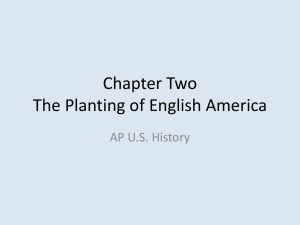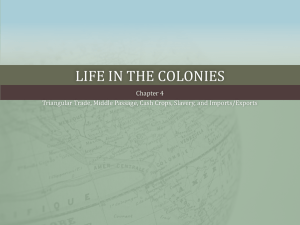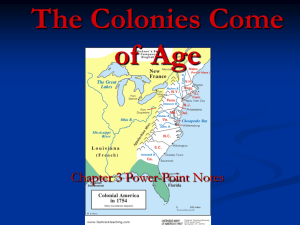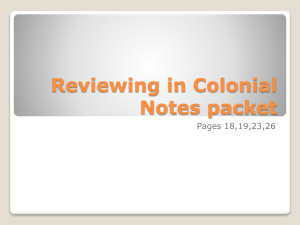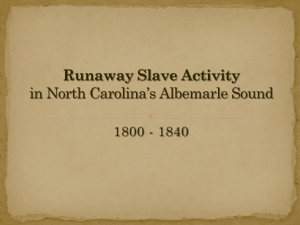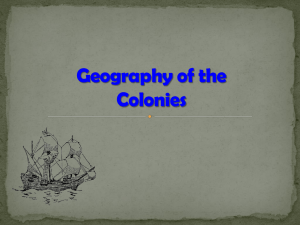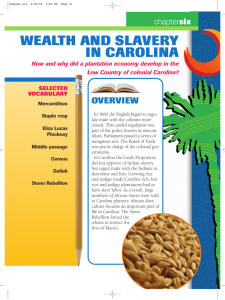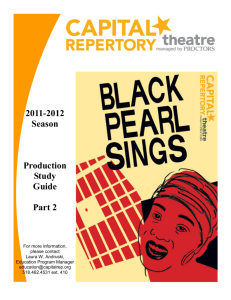Rice & Other Commodities of the Atlantic World
advertisement
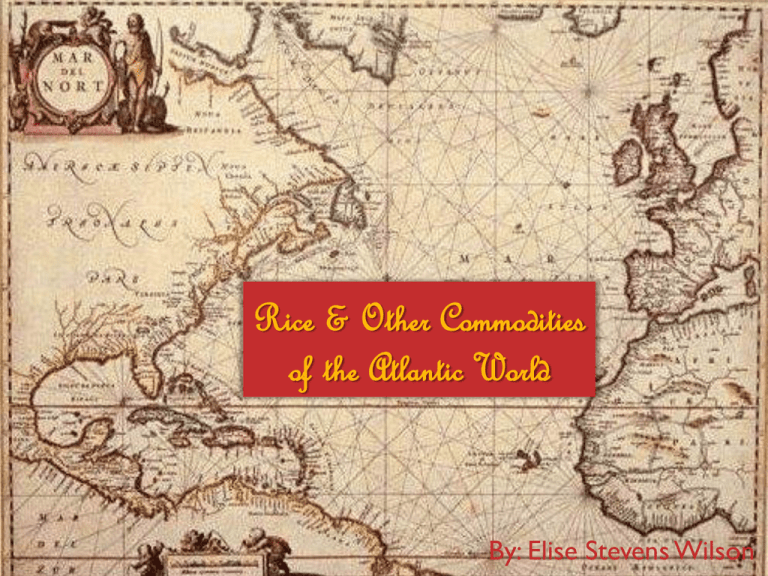
Rice & Other Commodities of the Atlantic World By: Elise Stevens Wilson Triangular Trade In the 17th and 18th centuries trade in the Atlantic grew rapidly. Europe, Africa, and the New World each had commodities to offer the others. Several trade triangles developed American Colonies -Rum -Fish -Tobacco -Rice -Lumber -Cotton -Indigo Caribbean -Sugar -Molasses -Slaves Europe -Copper -Guns -Manufactured goods -Textiles Africa -Enslaved men -Enslaved Women - Enslaved Children THE IMPORTANCE OF RICE IN SOUTH CAROLINA A Case Study of the Symbiotic Trade Relations in the Atlantic What is a symbiotic relationship? IT IS A RELATIONSHIP WHERE EACH INDIVIDUAL OR GROUP DEPENDS ON THE OTHER FOR SOMETHING. THEY BENEFIT EACH OTHER. It All Starts with Sugar When Europeans first started to settle in the New World, they quickly discovered a new product, sugar. They set up large sugar plantations in the Caribbean, like Barbados. They needed people to work on those plantations – African slaves South Carolina Feeds Barbados People seeking a fortune wanted to find ways to make money and acquire more land. South Carolina was “unclaimed” and was close to Barbados. So proprietors went in 1670 to seek their fortunes. Europeans tried various different crops, raised livestock, and cut down lumber to sell. In the beginning, livestock raised in South Carolina fed people in Barbados. South Carolina helped keep the sugar plantations functioning by supporting them with food. Later rice would be a major food staple. Barbados would send sugar and molasses which the American colonies would turn into rum. “ The only commodity of consequence produced in South Carolina is rice, and they reckon it as much their staple commodity, as sugar is to Barbados and Jamaica, or tobacco to Virginia and Maryland.” – James Glen, 1761 Finding Labor Native Indians seemed like a likely source of labor for the proprietors of South Journal Question: Carolina, but there were a couple of problems. ◦ Different language, customs Why do you think Europeans ◦ They know the land well – easier to run away chose enslaved Africans totribes be the ◦ Colonists feared retaliation from ◦ Nevertheless, Indians were used as slaves for main labor force in the colonies? generations European Labor European labor was appealing since white workers were familiar with customs and language. They also were familiar with clearing land and farming which Indians were not. But, white laborers had little motivation to work hard, and they were indentured servants, so there was a time limit for how long they had to work. African Labor Colonists looked to black slaves as a good source of labor even though they were an expensive initial investment. As with the native population, African slaves did not know the language and customs of the European settlers. But, most slaves entering South Carolina were coming from the English Caribbean, not directly from Africa, so the slaves had time to become acclimated to European culture. Additionally, Africans, unlike Europeans and Indians, were familiar with rice cultivation as it was a crop grown in West Africa. They brought this knowledge with them and helped to make rice a cash crop. Here is wording from an advertisement that appeared in the Evening Gazette in 1785, “a choice cargo of windward and gold coast negroes, who have been accustomed to the planting of rice.” Activity Each group will be given a picture of either rice production in South Carolina or triangular trade. 1. Feel free to circle or draw arrows to things you think are important. 2. Around the images, write down some observations or questions. 3. In at least 5 sentences write what you think life might have been like for any of the participants in this history. American Colonies -Rum -Fish -Tobacco -Rice -Lumber -Cotton -Indigo An Established Symbiotic Relationship Europe Rice, Rum Livestock, Rice Caribbean -Sugar -Molasses -Slaves -Copper -Guns -Manufactured goods -Textiles Slaves Slaves, Sugar Rum Slaves Africa -Enslaved men -Enslaved Women - Enslaved Children Source Citations Pictures Atlantic map http://www.google.com/imgres?imgurl=http://faculty.umf.maine.edu/walter.sargent/public.www/web%2520103/map%2520north%2520at lantic%2520historic.jpg&imgrefurl=http://faculty.umf.maine.edu/~walters/web%2520103/week%25201%2520umf%2520103_06.html&us g=__Lucltwvkr3i9YeEaFQnDfZinc1I=&h=378&w=496&sz=75&hl=en&start=0&zoom=1&tbnid=Ff3Hfga_yjsfBM:&tbnh=133&tbnw=152 &prev=/images%3Fq%3DAtlantic%2Bhistoric%2Bmap%26um%3D1%26hl%3Den%26sa%3DN%26rlz%3D1C1GGGE_enUS386US386%2 6biw%3D1024%26bih%3D651%26tbs%3Disch:1&um=1&itbs=1&iact=rc&dur=366&ei=VUh1TNShO4nSsAP5scigDQ&oei=VUh1TNSh O4nSsAP5scigDQ&esq=1&page=1&ndsp=16&ved=1t:429,r:7,s:0&tx=108&ty=44 Triangular trade http://gs2americanstudies.blogspot.com/ Europe outline http://cnx.org/content/m13082/latest/ Africa outline http://www.enchantedlearning.com/africa/rivers/outlinemap/ American Colonies outline http://www.freekidscoloring.com/13_colonies_map-16481.php Caribbean Outline http://www.enchantedlearning.com/geography/centamer/ Rice field http://docsouth.unc.edu/nc/king/ill283.html Sugar plantation http://abolition.e2bn.org/slavery_69.html South Carolina colony http://www.sonofthesouth.net/revolutionary-war/colonies/south-carolina.htm Indians and colonists http://texasliberal.wordpress.com/category/colonial-america/ Indentured servants http://www.newton.k12.ks.us/tech/13colonies.htm Triangular trade map http://www.socialstudiesforkids.com/graphics/triangulartrade.jpg Trade map http://americanhistory.abcclio.com/Search/Display/265722?terms=rice%20triangular%20trade&webSiteCode=SLN_AMHIST&returnToPage=/Search/Display/265 722%3fterms%3drice+triangular+trade&token=604E5450CD369B842BD9F2343662BCB8&casError=False Pictures of rice production http://docsouth.unc.edu/index.html ------------------------------------------------------------------------------------------------------------------------------------------------------------------------------ Quotes Wood, Peter. Black Majority. New York: Alfred A. Knopf, 1974. 35,, 60.

